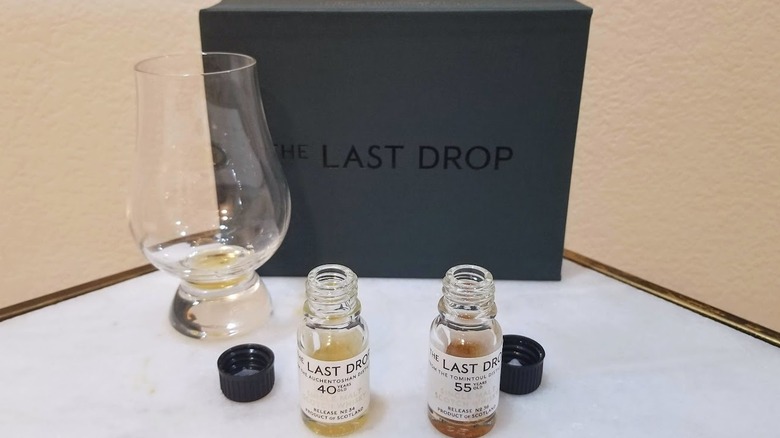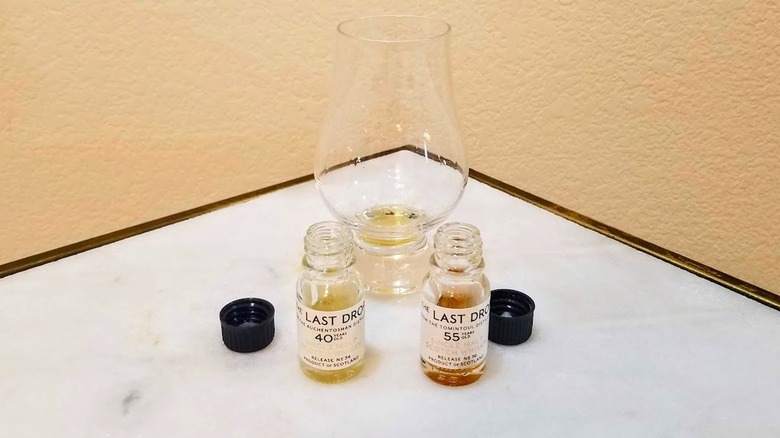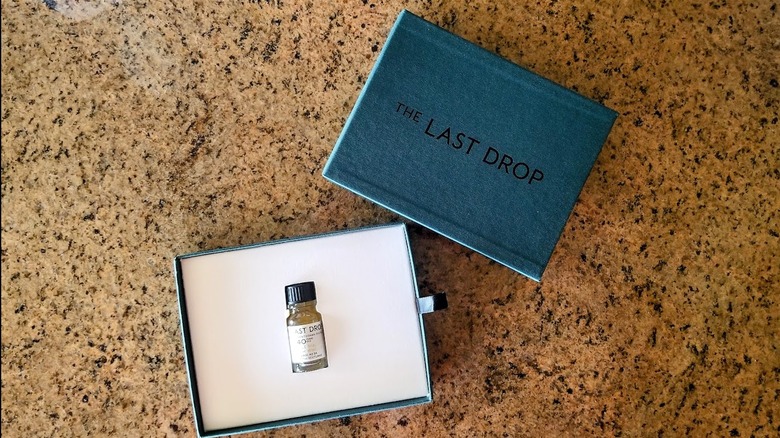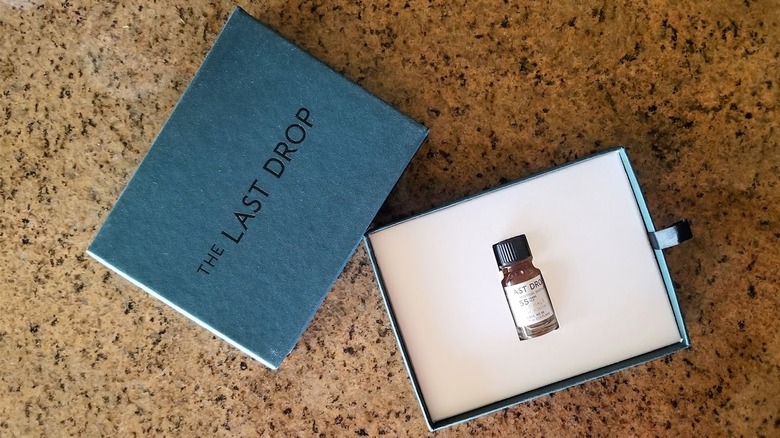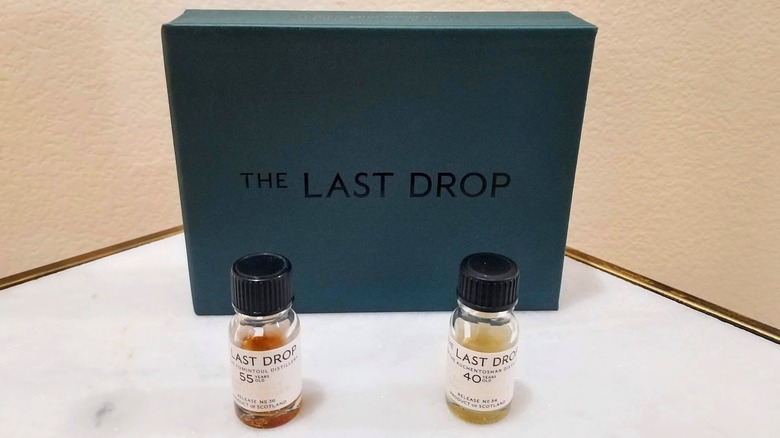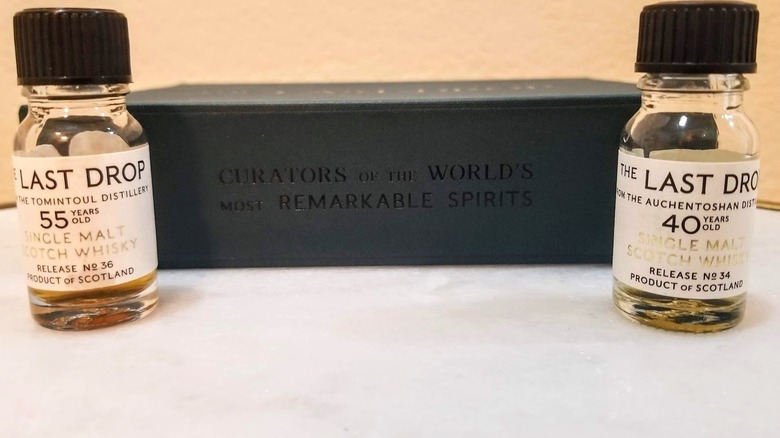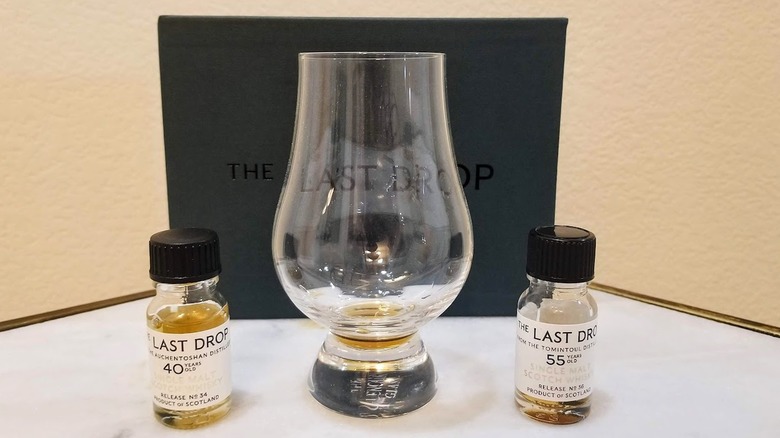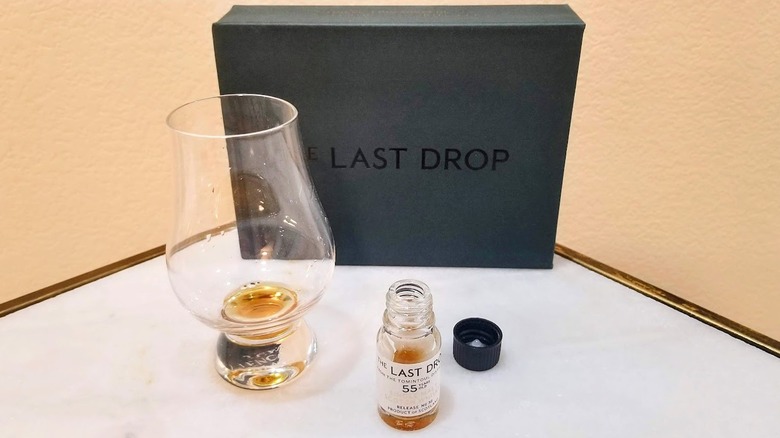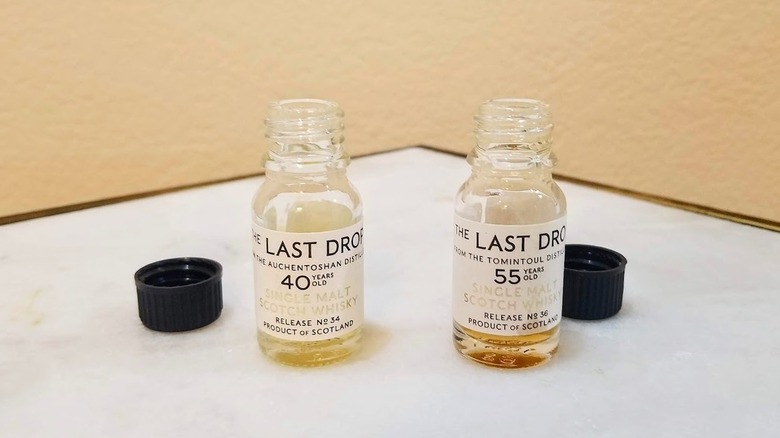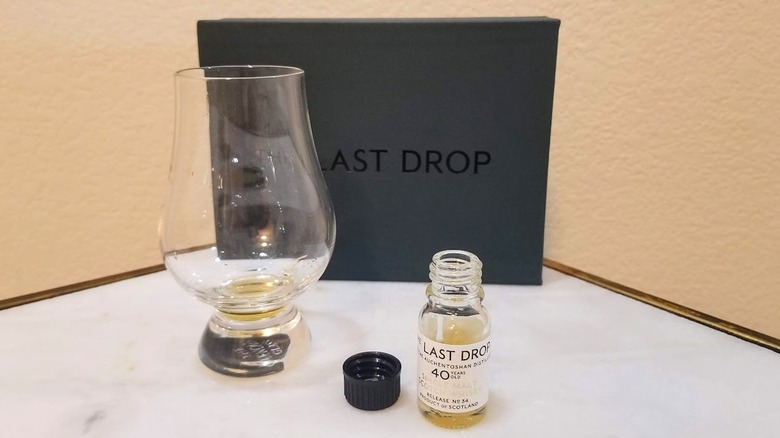Last Drop Single-Malt Scotch: 40-Year Vs 55-Year
Enjoying a dram of aged liquor evokes all of our senses, creating a multidimensional appreciation found by seeing, smelling, and tasting the spirit. It is a personal and emotional connection spirits lovers may feel, revealing memories of the past while giving us pleasure in the present. When that bottle is a highly aged single-malt scotch, it makes the hearts of whisky fans jump.
The scarcity of bottles that have aged for 40, 50, or more years is so slight that finding one gives scotch drinkers the opportunity to enjoy something rare that has been developing for decades. Tasting the spirit transports us back to a different place and time as we contemplate the history and provenance behind the bottle while also regarding the heritage and tradition that scotch whisky enjoys as a spirit with hundreds of years of production. Some enthusiasts buy these bottles for personal enjoyment, while others seek them out as an investment.
The Last Drop Distillers of London aims to bring high-end selections to spirits connoisseurs by curating limited-quantity liquor offerings. In May 2024, the spirits company released two highly aged single-malt scotch whiskies — a 40-year and a 55-year — each with a very limited number of pricey bottles. We received samples of each to perform a taste test, garnering if either is better and whether the bottles are worth the investment.
Some recommendations are based on first-hand impressions of promotional materials and products provided by the manufacturer/distributor/etc.
What is The Last Drop Distillers of London
In 2008, spirits industry veterans Tom Jago and James Espey started The Last Drop Distillers of London. According to its website, the company's main goal is reportedly to "curate the world's most remarkable spirits, finding treasures across different spirit categories and sharing them with those who seek the genuinely extraordinary."
The word "remarkable" comes up a lot within this company's philosophy. But perhaps for good reason. Speaking with Forbes in 2021, managing director Rebecca Jago (co-founder Tom's daughter) explained, "What we're looking for in that respect is a rare but perfect balance of age, character, and vitality." She also claimed that upwards of 90% of the liquor that's taste-tested by the folks at The Last Drop isn't brought into its collection. Indeed, since its founding, this company has released only 36 offerings, three of which dropped in 2024. The Assembly, an independent board of industry experts specializing in various liquors, work alongside Rebecca to put together this collection — which has included bourbon, cognac, rum, and Japanese whisky.
Seemingly delivering a handcrafted experience with each bottle it releases, then, the brand may also ignite the interest and imagination of its customers — generally, enthusiasts of ultra-rare and premium spirits — by sharing each expression's alleged history and backstory. From there, The Last Drop celebrates the provenance, touching on the importance of terroir, premium ingredients, and high-quality aging casks that impart flavors and aromas — which is one of the main reasons liquor is aged in barrels.
40-Year-Old Auchentoshan Distillery Single Malt Scotch Whisky
Release No. 34 from The Last Drop Distillers of London is a Lowlands scotch from the historic Auchentoshan Distillery near Glasgow. This distillery has roots dating back to 1823. The single-malt scotch begins with unpeated malted barley, allowing the essence of the terroir to come through, while reportedly using water from Loch Katrine in the Scottish Highlands. When considering whisky production, water is essential as the base liquid that makes up 95% of whisky. Using water from the Highlands, a region known for being more rugged and rustic, in a Lowlands product — which is typically lighter in style — creates complexity and a well-rounded spirit.
Auchentoshan claims to be one of the few distilleries in the country to triple distill its scotch. When whisky is triple distilled, the process removes harsh, biting elements from the liquor, producing a smooth, delicate palate with concentrated flavors and refined character. The Last Drop's single cask produced just 72 bottles, as over 80% of the liquor reportedly went to the angel's share — the portion of cask-aging liquor that evaporates over time through the natural pores in the oak's staves.
The resulting liquid looks as if it has been aged for only a short time, as the soft golden hue — an effect of triple distillation — does not reflect a well-aged whisky. The taste, however, displays the scotch's age, showing notes of caramel, dried orange peel, and sweet spice, with a layer of unexpected freshness.
55-Year-Old Tomintoul Single Malt Scotch Whisky
The Last Drop's oldest single-malt scotch offering to date is from the Tomintoul Distillery in Speyside. The Northeast Highlands region is home to over half the distilleries in Scotland due to the quality of water from the River Spey. Highlands scotch tends to produce whiskies with an exceptionally flavorful palate showing honey, vanilla, sweet spice, and orchard fruit flavors, each enhanced by years of oak barrel aging. The scotch will take on the aging vessel's tastes, aromas, and characteristics, as mentioned.
This 55-year-old single-malt whisky is said to enter a cask clear to eventually enjoy a golden hue imparted by the barrel, making the type and time in the barrel of utmost importance. As the whisky ages, the color becomes deeper and darker. At the same time, fresh fruit and spice flavors transform into more dried fruits, toasted nuts, and toffee, as in The Last Drop's release No. 36.
Tomintoul reportedly placed this whisky in six casks just three years after the distillery's 1965 founding. It rested there until 2022, when the liquid was aged in an Amoroso butt, a cask the size of roughly 126 gallons, for an additional 20 months. The final harvest produced a mere 582 bottles. This additional aging appeared to give the scotch new life, bringing the whisky's spice characteristics to the forefront, revealing layers of sticky toffee pudding, dried prune and raisin, and hazelnut, with a deep amber color and finish that lingers tastefully on the palate.
Are The Last Drop's liquors expensive?
The limited quantities of these two new releases from The Last Drop Distillers are so scarce, resulting in two expensive single-malt scotches. The retail price for one of the 72 bottles of 40-Year-Old Auchentoshan Distillery Single Malt Scotch Whisky is $5,300, and $8,300 for the 55-Year-Old Tomintoul Single Malt Scotch Whisky.
However, the prices for these products are on par with other single-malt options of similar years. A bottle of 40-year-old Glenfiddich also sells for around $5,300, as does a bottle of Highland Park, and yet neither claims to have quite the same backstory as the selection from The Last Drop. A 55-year-old bottle of the Macallan Lalique Single Malt Scotch will set you back over $200,000, making The Last Drop's look like a bargain.
While each bottle is expensive, we appreciate the packaging. The Last Drop delivers both of its new releases in a quantity of 750 milliliters, the standard size for a bottle of alcohol. However, the product's packaging includes a 700-milliliter bottle and a miniature 50-milliliter bottle, allowing customers the opportunity to enjoy the smaller bottle over time as they either hold the larger option as an investment product or as it further ages in the bottle for future enjoyment.
Why are high-end aged liquors appealing?
The demand for high-end liquors has only increased in recent years, driving its value higher. According to the market research firm Future Market Insights, the world whisky market's value in 2023 was $84.3 billion, with a forecast to reach over $270 billion over the course of the next decade. A key driver in this growth is that today's consumers are willing to purchase premium, artisanal liquors — particularly millennials.
As traditional investment opportunities, like the stock market, can be volatile, investing in alternative areas where consumers have a personal connection continues to see growth, like in liquor, wine, or fine art. We spoke with Jonathan Adler about his opinion of why consumers are drawn to high-end, aged spirits, asking if it is the story behind the liquor or simply the investment itself. Adler is a Michelin-recognized bartender, award-winning certified sommelier, and the beverage director of Shinji's in New York City. Of purchasing expensive luxury liquors, he says, "The story usually drives the investment."
Food and beverage director Sayora Khamidova of Jimmy, Twenty Three Grand, and Jumpin Jacks at ModernHaus SoHo in New York City agrees. When asked if the provenance or pedigree makes aged liquors alluring, or if it's the limited quantity and rarity, she tells us, "It's a combination of both: the investment potential and the compelling story behind the spirit often drive purchases of luxury liquors."
When is it worth investing in high-end spirits?
Sayora Khamidova, who also invented the hot Negroni cocktail for the rooftop bar Jimmy, shares her opinion on investing in luxury spirits. "Aged spirits have a special charm because of their rich history and craftsmanship," she tells us. "People are drawn to their rarity, limited availability, and the unique taste developed over time."
However, when asking Jonathan Adler if the importance of purchasing luxury alcohol lies in the spirit's pedigree or the investment opportunity, he says, "Unusually enough, the taste of a rare spirit [generally] comes less into play for bottles that command a price over $2,000, as these will most likely never be consumed, except in a restaurant or bar setting." Adler adds, "There is a whole market of consumers purchasing whiskies ... only to wait for them to appreciate in value and resell them either privately or in large lots." He also notes that, while this move can be risky, the same is true of investing in any luxury item, including cars, jewelry, and clothes.
Khamidova offers advice when investing in premium liquors, saying to keep an eye out for unique production methods and limited editions. She also suggests always seeking advice from experts or collectors before making an investment.
How to drink The Last Drop's spirits
The Last Drop prides itself on curating what it claims to be only the finest liquors — and as such, you will want to enjoy these two options neat. The quality of both the 40-year and 55-year releases are too refined for classic scotch whisky cocktails, like adding it to vermouth and bitters for a Rob Roy or watering it down in a scotch and soda. The opulence of the luxurious profile, then, should not be neutralized with other spirits or mixes. If the alcohol's palate is too strong, add just a drop of filtered water.
The best glass to drink whisky neat is a classic Glencairn. The glass is short, with a broad, round bowl that rises to a tulip shape, narrowing at the top. The difference between a Glencairn and a snifter is that the former is slimmer, without as much of a bulbous bowl. However, the latter will work in a pinch. With a narrow shape at the top, both glasses will allow you to swirl the whisky while concentrating the aromas, ensuring you can capture the entire essence of the spirit.
Both of The Last Drop's scotch whisky releases boast palates that are so smooth, and the flavors are so pure that adding ice or a splash of water may mask some intricacies. While the whisky should not be warm, it should also not be too cold. Chilling the liquid will hide each well-aged liquor's subtle nuances, dulling the aromas.
The Last Drop's 40-year vs 55-year single-malt scotch
The Last Drop's 40-Year-Old Auchentoshan Distillery Single Malt Scotch Whisky has a graceful and balanced palate, with the aforementioned citrus and orchard fruit notes, as well as a freshness that was surprising for a spirit that has been in a cask for decades. The 55-Year-Old Tomintoul Distillery Single Malt Scotch Whisky is bold, rich, and complex, with those previously noted layers of sticky toffee, dark chocolate, candied ginger, and dried fruits. Though more expensive, the latter may not be the best option, as extensively aged whisky isn't always better if you prefer something more delicate. However, if your preference is a full-bodied spirit with a concentrated, unctuous palate, you will enjoy the 55-year-old option.
The alcohol percentage is higher in the Auchentoshan at 44.8% alcohol by volume, versus the 41.7% ABV in the Tomintoul. This was unexpected, as the alcohol burn appears more dominant in the latter. However, a single drop of water helps soften the bite, revealing the whisky's many layers.
Regarding one versus the other, our preference would be the 40-year-old due to the incredible freshness the spirit still has and the elegant nature of the palate. While the 55-year-old offering is luscious and extremely palatable, the 40-year-old — with its refinement — is enough to steal the heart of this whisky lover.
Is The Last Drop's single-malt scotch worth the investment?
For history lovers, adventure seekers, and connoisseurs of fine whisky with an appreciation for artistry in a glass, The Last Drop single-malt scotch whisky releases No. 34 (40-year) and No. 36 (55-year) are well worth the investment. The quality of the products is undeniable, as both artisanal whiskies have seemingly been meticulously cared for over the past several decades.
Jonathan Adler says that when investing in high-end spirits, "Look to the market to see what categories are already in high demand and try to find smaller or unknown distilleries that are producing limited releases." As so few bottles of each of The Last Drop's new scotch whiskies are available, the options fall into this category.
With that in mind, Jessica King, co-owner and operator of Brother Wolf, Osteria Stella, and Lilou in Knoxville, Tennessee, takes a slightly different approach. "Stop waiting for the perfect occasion to crack that special bottle," she tells us of buying premium spirits. "... If you only buy fancy bottles to resell them, you're missing the best part." Whether you buy the bottle to enjoy now or sell later, scotch fans and serious collectors who also have deep pockets will appreciate both of The Last Drop's recent offerings.
